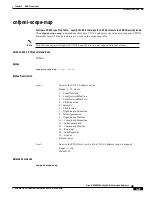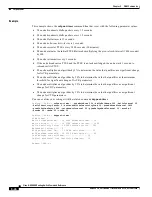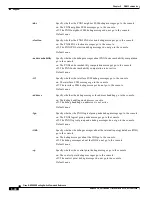
5-37
Cisco MGX 8850 Routing Switch Command Reference
Release 2.0, Part Number 78-10467-04 Rev C0, October 2001
Chapter 5
PNNI Commands
cnfpnni-routing-policy
-loadBalance
The PNNI routing protocol relies on the load balance policy when it determines
that the routes to a destination have equal cost. (PNNI determines routes to be
identical according to the metrics in the AW, CDV, or CTD routing table.) Note
that the SPT epsilon value can be a factor when PNNI calculates cost.
The choice for load balancing is “random” or “maxbw.” Type the entire word.
With “random” load balancing, PNNI randomly chooses between the equal cost
routes. This rule requires less computational overhead.
With “maxbw” load balancing, PNNI selects the route with more available
bandwidth when it chooses between equal cost routes. This rule has more
overhead due to ongoing comparison of available bandwidth on the routes.
Default: no default
-onDemand
On-demand routing applies to crankback or a situation where the node must
route a call to a destination for which no route exists in the pre-computed routing
tables. The on-demand policy is either “firstfit” and “bestfit.”
With firstfit (the default), PNNI selects the first route to the destination. This
approach minimizes search time but may not result in the best route.
With bestfit, PNNI selects a route based on:
•
The route with the lowest cost (see AW in the cnfpnni-intf description and
maxcost in the addcon description because these parameters are closely
related).
•
Link verification.
•
Path constraint checks.
•
Avoidance of blocked nodes and links.
•
Checking limits in the designated transit list (DTL).
With bestfit, PNNI selects the optimum route but entails greater computing
overhead. The search-time depends on the density and complexity of the
network.
Default: firstfit
-awBgTable
Enable or disable the background routing table for AW.
on: The background routing table of AW is enabled.
off: The background routing table of AW is disabled.
Default: on
















































